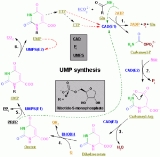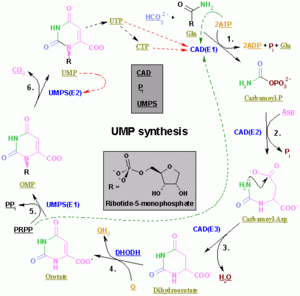
Pyrimidine metabolism
Encyclopedia
Pyrimidine biosynthesis occurs both in the body and through organic synthesis.
s are assembled before being attached to 5-phosphoribosyl-1-pyrophosphate (PRPP).

The first three enzymes are all coded by the same gene in Metazoa (CAD
). In Fungi, a similar protein exists but lacks the dihydroorotase function: another protein catalyzes the second step.
In other organisms (Bacteria
, Archaea
and the other Eukaryota), the first three steps are done by three different enzymes.
(degraded) to CO2
, H2O, and urea
. Cytosine can be broken down to uracil
which can be further broken down to N-carbamoyl-β-alanine. Thymine is broken down into β-aminoisobutyrate which can be further broken down into intermediates eventually leading into the citric acid cycle
.
β-aminoisobutyrate acts as a rough indicator for rate of DNA turnover.
Pyrimidine synthesis inhibitors are used in active moderate to severe rheumatoid arthritis
and psoriatic arthritis
. Examples include Leflunomide
and Teriflunomide
.
De novo biosynthesis of pyrimidine
Unlike purines, pyrimidinePyrimidine
Pyrimidine is a heterocyclic aromatic organic compound similar to benzene and pyridine, containing two nitrogen atoms at positions 1 and 3 of the six-member ring...
s are assembled before being attached to 5-phosphoribosyl-1-pyrophosphate (PRPP).

| Enzyme | Product | Description >- | carbamoyl phosphate synthetase II |
carbamoyl phosphate Carbamoyl phosphate Carbamoyl phosphate is an anion of biochemical significance. In land-dwelling animals it is an intermediary metabolite participating in the nitrogen disposal through in the urea cycle and the synthesis of pyrimidines.... |
>- | carbamoyl aspartic acid Carbamoyl aspartic acid Carbamoyl aspartic acid is a carbamate derivative which serves as an intermediate in pyrimidine biosynthesis.... |
>- | dihydroorotate | >- | orotate | >- | OMP | >- | UMP Uridine monophosphate Uridine monophosphate, also known as 5'-uridylic acid and abbreviated UMP, is a nucleotide that is used as a monomer in RNA. It is an ester of phosphoric acid with the nucleoside uridine... |
>- | UDP Uridine diphosphate Uridine diphosphate, abbreviated UDP, is a nucleoside diphosphate. It is an ester of pyrophosphoric acid with the nucleoside uridine. UDP consists of the pyrophosphate group, the pentose sugar ribose, and the nucleobase uracil.-See also:* Nucleoside... |
>- | UTP Uridine 5'-triphosphate Uridine-5'-triphosphate is a pyrimidine nucleoside triphosphate, consisting of the organic base uracil linked to the 1' carbon of the ribose sugar, and esterified with tri-phosphoric acid at the 5' position... |
>- | CTP | Glutamine Glutamine Glutamine is one of the 20 amino acids encoded by the standard genetic code. It is not recognized as an essential amino acid but may become conditionally essential in certain situations, including intensive athletic training or certain gastrointestinal disorders... and ATP are used. |
The first three enzymes are all coded by the same gene in Metazoa (CAD
CAD (gene)
CAD is a gene which encodes several enzymes involved in pyrimidine biosynthesis. De-novo synthesis starts with cytosolic carbamoylphosphate synthetase II which uses glutamine, carbon dioxide and 2 ATP. This enzyme is inhibited by UTP....
). In Fungi, a similar protein exists but lacks the dihydroorotase function: another protein catalyzes the second step.
In other organisms (Bacteria
Bacteria
Bacteria are a large domain of prokaryotic microorganisms. Typically a few micrometres in length, bacteria have a wide range of shapes, ranging from spheres to rods and spirals...
, Archaea
Archaea
The Archaea are a group of single-celled microorganisms. A single individual or species from this domain is called an archaeon...
and the other Eukaryota), the first three steps are done by three different enzymes.
Pyrimidine catabolism
Pyrimidines are ultimately catabolizedCatabolism
Catabolism is the set of metabolic pathways that break down molecules into smaller units and release energy. In catabolism, large molecules such as polysaccharides, lipids, nucleic acids and proteins are broken down into smaller units such as monosaccharides, fatty acids, nucleotides, and amino...
(degraded) to CO2
Carbon dioxide
Carbon dioxide is a naturally occurring chemical compound composed of two oxygen atoms covalently bonded to a single carbon atom...
, H2O, and urea
Urea
Urea or carbamide is an organic compound with the chemical formula CO2. The molecule has two —NH2 groups joined by a carbonyl functional group....
. Cytosine can be broken down to uracil
Uracil
Uracil is one of the four nucleobases in the nucleic acid of RNA that are represented by the letters A, G, C and U. The others are adenine, cytosine, and guanine. In RNA, uracil binds to adenine via two hydrogen bonds. In DNA, the uracil nucleobase is replaced by thymine.Uracil is a common and...
which can be further broken down to N-carbamoyl-β-alanine. Thymine is broken down into β-aminoisobutyrate which can be further broken down into intermediates eventually leading into the citric acid cycle
Citric acid cycle
The citric acid cycle — also known as the tricarboxylic acid cycle , the Krebs cycle, or the Szent-Györgyi-Krebs cycle — is a series of chemical reactions which is used by all aerobic living organisms to generate energy through the oxidization of acetate derived from carbohydrates, fats and...
.
β-aminoisobutyrate acts as a rough indicator for rate of DNA turnover.
Pharmacotherapy
Modulating the pyrimidine metabolism pharmacologically has therapeutical uses.Pyrimidine synthesis inhibitors are used in active moderate to severe rheumatoid arthritis
Rheumatoid arthritis
Rheumatoid arthritis is a chronic, systemic inflammatory disorder that may affect many tissues and organs, but principally attacks synovial joints. The process produces an inflammatory response of the synovium secondary to hyperplasia of synovial cells, excess synovial fluid, and the development...
and psoriatic arthritis
Psoriatic arthritis
Psoriatic arthritis is a type of inflammatory arthritis that, according to the National Psoriasis Foundation, will develop in up to 30 percent of people who have the chronic skin condition psoriasis...
. Examples include Leflunomide
Leflunomide
Leflunomide is a medication of the DMARD type, used in active moderate to severe rheumatoid arthritis and psoriatic arthritis. It is a pyrimidine synthesis inhibitor.-Basic chemical, pharmacological, and marketing data:...
and Teriflunomide
Teriflunomide
Teriflunomide is the active metabolite of leflunomide. Teriflunomide was investigated in the Phase III clinical trial TEMSO as a medication for multiple sclerosis . The study was completed in July 2010...
.
External links
- Overview at Queen Mary, University of LondonQueen Mary, University of LondonQueen Mary, University of London is a public research university located in London, United Kingdom and a constituent college of the federal University of London...

